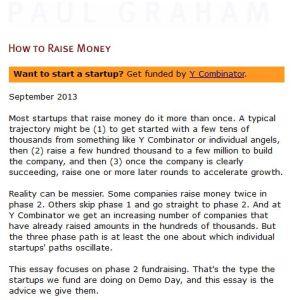
Paul Graham
How To Raise Money
Paul Graham, 2013
What's inside?
Y Combinator co-founder Paul Graham provides valuable insight on how to raise funds for your start-up successfully.
Recommendation
Two fears plague investors: They’ll invest in a start-up that flounders, or they’ll miss out on one that thrives. These conflicting fears often lead to confusing investor behavior that inexperienced start-up founders may misinterpret. The result is a recipe for start-up failure. Co-founder of the successful seed accelerator Y Combinator Paul Graham gives start-ups a set of applicable “if-then” rules to assist the fundraising process. getAbstract recommends this practical guide to entrepreneurs, CEOs and anyone navigating fund raising for a start-up.
Take-Aways
- Startups should have distinct “phase one” and “phase two” fund raising stages, and only the CEO should focus on raising money.
- Investors’ intentions aren’t always clear. Entrepreneurs should pay attention to investors’ actions, not their words.
- Always talk to more than one investor; prioritize investors who won’t take up much of your time and can help you the most.
- Avoid dealing with investors who “don’t lead” or claim to be “valuation sensitive.”
- Stop fund raising while you’re ahead; when investor interest slows down, turn your attention back to building your business.
Summary
Start-ups should have distinct “phase one” and “phase two” fund raising stages. In phase one, you should “accept offers greedily,” while in phase two, you should be more selective. Fund raising isn’t what makes a start-up successful; the real challenge is building a product and then “listening to users complain” about that product so you can improve it. Preparing materials to convince investors is a distraction from the important work. Get it over with as quickly as possible. If investors contact you when you’re not in a fund raising phase, only let them invest if they offer terms that are acceptable with no negotiations. Meetings and negotiations with investors should only take place during a fund raising phase.
“When you do decide to raise money, you should focus your whole attention on it, so you can get it done quickly and get back to work.”
When fund raising, always be in contact with multiple investors at a time. Working with multiple investors encourages action. Prioritize investors according to how easily they’ll say yes and how helpful they’re likely to be. If an investor “doesn’t lead” or is “valuation sensitive,” deal with them last, if at all. Investor behavior is often misleading. If you’re unsure what stage of the process you’re in, it’s all right to ask what their investment process entails and where you stand within it. If they resist answering, be wary.
“Investors are fine with funding nerds. So if you’re a nerd, just try to be a good nerd, rather than doing a bad imitation of a smooth salesman.”
What should you say when investors ask how much you plan to raise? Adjust your number depending on the investor and how much they might offer. Starting low has several advantages and almost no disadvantages. You can always raise more money than initially planned. If you’re lucky enough to need to put a cap on investments, a good equation to use is the number of people you wish to hire times 18 months times $15,000. Then add production costs, if there are any. The resulting number should represent your upper limit, and you shouldn’t actually spend that much. Don’t raise more than you need. Sell less than 15% in phase one and less than 25% in phase two.
“It’s a mistake to behave arrogantly to investors...A flick of the whip that will bring one to heel will make another roar with indignation. The only safe strategy is never to seem arrogant at all.”
Only the CEO should handle raising money. The other founders should focus on growing the business. Meet investors when you are armed with a one-page executive summary, always be polite and make sure you know the next step before you leave the meeting. Don’t get addicted to fund raising and stop when interest slows down. Then put your attention back where it belongs: making things, talking to people and growing the business.
About the Author
Paul Graham is a programmer, writer and investor. He co-founded Y Combinator, one of the most successful seed accelerators in the world.
This document is restricted to personal use only.
My Highlights
Did you like this summary?
Read the articleThis summary has been shared with you by getAbstract.
We find, rate and summarize relevant knowledge to help people make better decisions in business and in their private lives.
Already a customer? Log in here.

















Comment on this summary